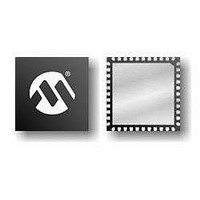PIC16F1519-E/MV Microchip Technology, PIC16F1519-E/MV Datasheet - Page 57

PIC16F1519-E/MV
Manufacturer Part Number
PIC16F1519-E/MV
Description
40-pin, 28KB Flash, 1024B RAM, 10-bit ADC, 2xCCP, SPI, MI2C, EUSART, 2.3V-5.5V 4
Manufacturer
Microchip Technology
Series
PIC® XLP™ 16Fr
Datasheet
1.PIC16F1516-EMV.pdf
(344 pages)
Specifications of PIC16F1519-E/MV
Processor Series
PIC16F151x
Core
PIC
Data Bus Width
8 bit
Program Memory Type
Flash
Program Memory Size
16 KB
Data Ram Size
1 KB
Interface Type
I2C, SPI, USART
Maximum Clock Frequency
20 MHz
Number Of Programmable I/os
36
Number Of Timers
3
Operating Supply Voltage
2.3 V to 5.5 V
Maximum Operating Temperature
+ 125 C
Mounting Style
SMD/SMT
Package / Case
QFN-40
Core Processor
PIC
Core Size
8-Bit
Speed
20MHz
Connectivity
I²C, LIN, SPI, UART/USART
Peripherals
Brown-out Detect/Reset, POR, PWM, WDT
Number Of I /o
36
Eeprom Size
-
Ram Size
1K x 8
Voltage - Supply (vcc/vdd)
2.3 V ~ 5.5 V
Data Converters
A/D 28x10b
Oscillator Type
Internal
Operating Temperature
-40°C ~ 125°C
Lead Free Status / Rohs Status
Details
- Current page: 57 of 344
- Download datasheet (3Mb)
5.2.2.3
The system clock speed can be selected via software
using the Internal Oscillator Frequency Select bits
IRCF<3:0> of the OSCCON register.
The output of the 16 MHz HFINTOSC and 31 kHz
LFINTOSC connects to a postscaler and multiplexer
(see
Select bits IRCF<3:0> of the OSCCON register select
the frequency output of the internal oscillators. One of
the following frequencies can be selected via software:
• 16 MHz
• 8 MHz
• 4 MHz
• 2 MHz
• 1 MHz
• 500 kHz (Default after Reset)
• 250 kHz
• 125 kHz
• 62.5 kHz
• 31.25 kHz
• 31 kHz (LFINTOSC)
The IRCF<3:0> bits of the OSCCON register allow
duplicate selections for some frequencies. These dupli-
cate choices can offer system design trade-offs. Lower
power consumption can be obtained when changing
oscillator sources for a given frequency. Faster transi-
tion times can be obtained between frequency changes
that use the same oscillator source.
2011 Microchip Technology Inc.
Note:
Figure
Following any Reset, the IRCF<3:0> bits
of the OSCCON register are set to ‘0111’
and the frequency selection is set to
500 kHz. The user can modify the IRCF
bits to select a different frequency.
5-1). The Internal Oscillator Frequency
Internal Oscillator Frequency
Selection
Preliminary
5.2.2.4
When switching between the HFINTOSC and the
LFINTOSC, the new oscillator may already be shut
down to save power (see
there is a delay after the IRCF<3:0> bits of the
OSCCON register are modified before the frequency
selection takes place. The OSCSTAT register will
reflect the current active status of the HFINTOSC and
LFINTOSC oscillators. The sequence of a frequency
selection is as follows:
1.
2.
3.
4.
5.
6.
7.
See
If the internal oscillator speed is switched between two
clocks of the same source, there is no start-up delay
before the new frequency is selected. Clock switching
time delays are shown in
Start-up delay specifications are located in the
oscillator
Specifications”
PIC16(L)F1516/7/8/9
IRCF<3:0> bits of the OSCCON register are
modified.
If the new clock is shut down, a clock start-up
delay is started.
Clock switch circuitry waits for a falling edge of
the current clock.
The current clock is held low and the clock
switch circuitry waits for a rising edge in the new
clock.
The new clock is now active.
The OSCSTAT register is updated as required.
Clock switch is complete.
Figure 5-7
tables
Internal Oscillator Clock Switch
Timing
for more details.
of
Figure
Table
Section 25.0
5-1.
5-7). If this is the case,
DS41452B-page 57
“Electrical
Related parts for PIC16F1519-E/MV
Image
Part Number
Description
Manufacturer
Datasheet
Request
R

Part Number:
Description:
IC, 8BIT MCU, PIC16F, 32MHZ, SOIC-18
Manufacturer:
Microchip Technology
Datasheet:

Part Number:
Description:
IC, 8BIT MCU, PIC16F, 32MHZ, SSOP-20
Manufacturer:
Microchip Technology
Datasheet:

Part Number:
Description:
IC, 8BIT MCU, PIC16F, 32MHZ, DIP-18
Manufacturer:
Microchip Technology
Datasheet:

Part Number:
Description:
IC, 8BIT MCU, PIC16F, 32MHZ, QFN-28
Manufacturer:
Microchip Technology
Datasheet:

Part Number:
Description:
IC, 8BIT MCU, PIC16F, 32MHZ, QFN-28
Manufacturer:
Microchip Technology
Datasheet:

Part Number:
Description:
IC, 8BIT MCU, PIC16F, 32MHZ, QFN-28
Manufacturer:
Microchip Technology
Datasheet:

Part Number:
Description:
IC, 8BIT MCU, PIC16F, 32MHZ, SSOP-20
Manufacturer:
Microchip Technology
Datasheet:

Part Number:
Description:
IC, 8BIT MCU, PIC16F, 20MHZ, DIP-40
Manufacturer:
Microchip Technology
Datasheet:

Part Number:
Description:
IC, 8BIT MCU, PIC16F, 32MHZ, QFN-28
Manufacturer:
Microchip Technology
Datasheet:

Part Number:
Description:
IC, 8BIT MCU, PIC16F, 20MHZ, MQFP-44
Manufacturer:
Microchip Technology
Datasheet:

Part Number:
Description:
IC, 8BIT MCU, PIC16F, 20MHZ, QFN-20
Manufacturer:
Microchip Technology
Datasheet:

Part Number:
Description:
IC, 8BIT MCU, PIC16F, 32MHZ, QFN-28
Manufacturer:
Microchip Technology
Datasheet:

Part Number:
Description:
MCU 14KB FLASH 768B RAM 64-TQFP
Manufacturer:
Microchip Technology
Datasheet:

Part Number:
Description:
7 KB Flash, 384 Bytes RAM, 32 MHz Int. Osc, 16 I/0, Enhanced Mid Range Core, Low
Manufacturer:
Microchip Technology

Part Number:
Description:
14KB Flash, 512B RAM, 256B EEPROM, LCD, 1.8-5.5V 40 UQFN 5x5x0.5mm TUBE
Manufacturer:
Microchip Technology
Datasheet:










